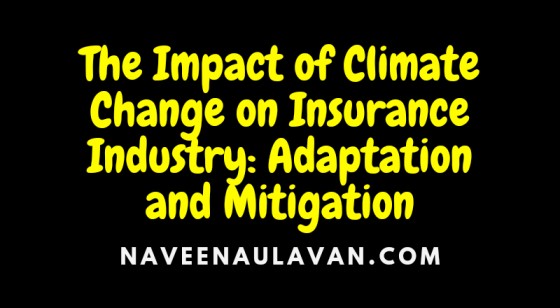Climate change is one of the most pressing challenges of our time, with far-reaching implications for various sectors of the economy. The insurance industry, in particular, is significantly affected by the changing climate patterns and increased frequency of extreme weather events. The risks associated with climate change pose substantial challenges to insurers, requiring them to adapt and mitigate the potential impacts. In this article, we will explore the specific impacts of climate change on the insurance industry, discuss strategies for adaptation, and highlight the importance of mitigation efforts.
Climate Change and Increased Risk Exposure
Changing Weather Patterns
Climate change has resulted in significant alterations in weather patterns worldwide. Rising temperatures have led to more frequent and intense heatwaves, while changing precipitation patterns have increased the likelihood of extreme rainfall and flooding events. These changes directly impact the insurance industry, as they increase the frequency and severity of weather-related claims.
Increasing Frequency of Extreme Weather Events
Extreme weather events, such as hurricanes, wildfires, and storms, are becoming more common due to climate change. These events cause extensive property damage, loss of life, and disruption to businesses and communities. For insurers, the increased frequency of such events means a higher number of claims, leading to financial losses and potential solvency risks.
Challenges Faced by the Insurance Industry
Increased Payouts and Losses
As climate-related events become more frequent and severe, insurance companies face a significant increase in payouts and losses. The costs associated with property damage, business interruption, and liability claims skyrocket in the wake of extreme weather events. Insurers must carefully manage their reserves and pricing models to ensure they can meet their obligations while remaining financially sustainable.
Uncertain Risk Assessment
Climate change introduces a new level of uncertainty in risk assessment for insurers. Traditional actuarial models may no longer accurately predict the likelihood and magnitude of future weather-related events. Insurers must incorporate climate science, catastrophe modeling, and advanced data analytics to enhance their risk assessment capabilities and develop new underwriting strategies.
Reinsurance Market Challenges
Reinsurers, which provide insurance to insurance companies, are also affected by climate change. They face higher losses due to increased payouts from primary insurers. This situation can lead to a rise in reinsurance premiums, which, in turn, impacts the affordability of insurance coverage for policyholders. The insurance industry needs to foster collaboration between primary insurers and reinsurers to address these challenges effectively.
Adaptation Strategies for the Insurance Industry
Enhanced Risk Modeling and Data Analytics
To adapt to the changing risk landscape, insurers must invest in sophisticated risk modeling and data analytics tools. These technologies can help insurers better understand climate-related risks, assess vulnerabilities, and price policies accordingly. By leveraging big data and advanced analytics, insurers can improve their underwriting and claims management processes, ultimately enhancing their ability to withstand climate-related losses.
Diversification and Product Innovation
Insurance companies can mitigate their exposure to climate-related risks by diversifying their portfolios and offering innovative products. By expanding coverage options, insurers can address emerging risks associated with climate change, such as parametric insurance for extreme weather events or coverage for renewable energy projects. Diversification helps spread risk and reduces the impact of climate-related losses on overall profitability.
Collaboration and Knowledge Sharing
The insurance industry should foster collaboration and knowledge sharing among insurers, reinsurers, policymakers, and scientific communities. Sharing data, best practices, and research findings can enhance the industry’s understanding of climate-related risks and enable the development of effective adaptation strategies. Public-private partnerships can play a crucial role in developing joint initiatives and building resilience against climate change impacts.
Importance of Mitigation Efforts
Supporting Sustainable Practices
In addition to adaptation strategies, the insurance industry also plays a vital role in supporting and promoting sustainable practices that help mitigate climate change. Insurers can encourage policyholders to adopt environmentally friendly measures by offering incentives, such as lower premiums for energy-efficient buildings or vehicles. By promoting sustainable practices, insurers contribute to reducing greenhouse gas emissions and fostering a more resilient and sustainable future.
Incorporating Climate Risk in Investment Decisions
Insurance companies are major institutional investors with significant portfolios. They have the power to influence investment decisions and direct capital towards climate-friendly projects. By integrating climate risk considerations into their investment strategies, insurers can support the transition to a low-carbon economy. This includes divesting from fossil fuel-related assets and investing in renewable energy, green infrastructure, and other climate-resilient sectors.
Engaging in Climate Advocacy
Insurance industry associations and companies can engage in climate advocacy efforts to promote policies that address the root causes of climate change. By actively participating in policy discussions and supporting initiatives for carbon pricing, renewable energy incentives, and emissions reduction targets, insurers can contribute to shaping a favorable regulatory environment that fosters climate mitigation efforts.
Encouraging Resilient Infrastructure Development
Insurers can incentivize the development of resilient infrastructure by providing coverage and risk assessments for projects that incorporate climate adaptation measures. By encouraging investments in climate-resilient infrastructure, such as flood defenses or building designs that can withstand extreme weather events, insurers contribute to reducing vulnerabilities and minimizing the potential for future losses.
Conclusion
Climate change poses significant challenges to the insurance industry, as it increases risk exposure, alters risk assessment practices, and strains financial sustainability. However, insurers have the opportunity to adapt and mitigate the impacts of climate change by implementing various strategies. Enhanced risk modeling, product innovation, collaboration, and supporting sustainable practices are crucial for adapting to the changing risk landscape. Additionally, insurers can contribute to climate mitigation efforts by incorporating climate risk in investment decisions, engaging in climate advocacy, and encouraging resilient infrastructure development. By proactively addressing climate change risks, the insurance industry can play a pivotal role in building resilience and fostering a sustainable future for all.
Next Post And Your Code Is – G